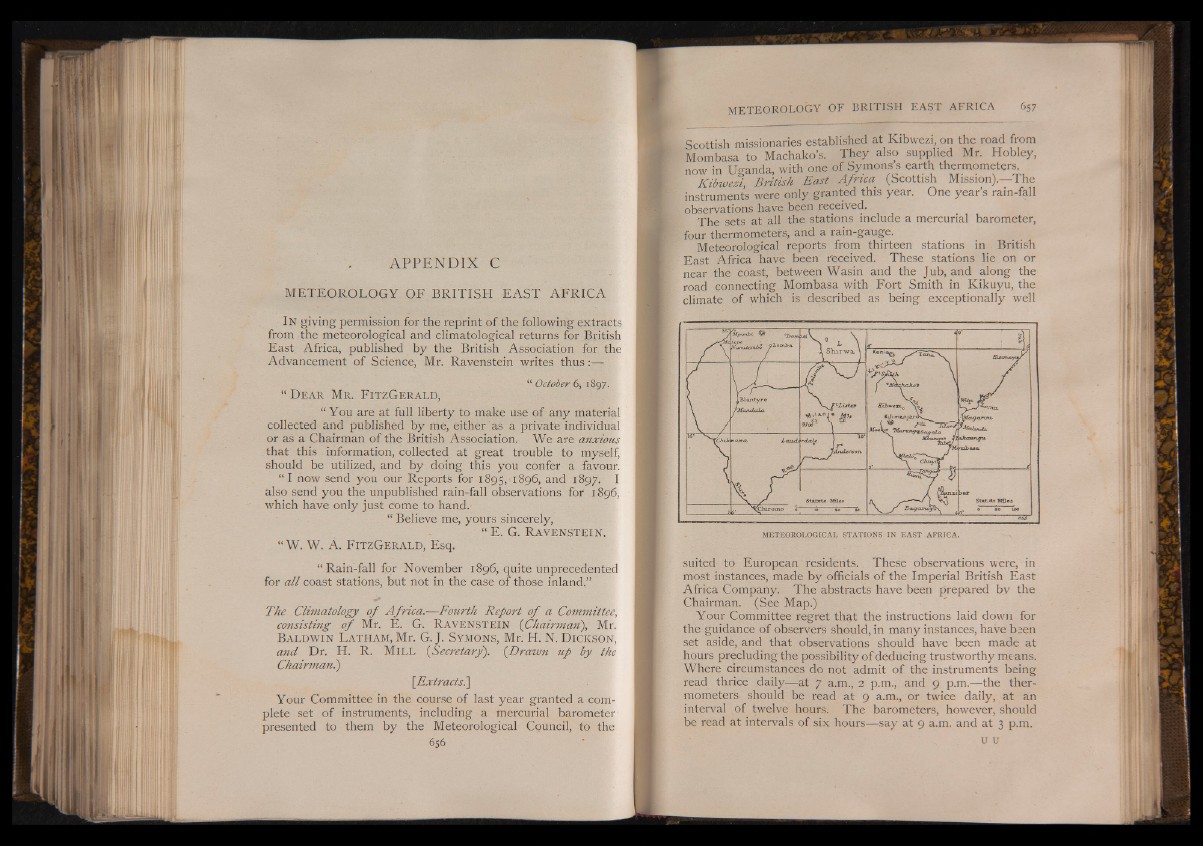
A P P EN D IX C
METEOROLOGY OF BRITISH E A ST A FR IC A
In giving permission for the reprint of the following extracts
from the meteorological and climatological returns for British
East Africa, published by the British Association for the
Advancement of Science, Mr. Ravenstein writes thus:—
“ October 6, 1897.
“ D e a r M r . F i t z G e r a l d ,
“ You are at full liberty to make use of any material
collected and published by me, either as a private individual
or as a Chairman of the British Association. We are anxious
that this information, collected at great trouble to myself,
should be utilized, and by doing this you confer a favour.
“ I now send you our Reports for 1895, 1896, and 1897. I
also send you the unpublished rain-fall observations for 1896,
which have only just come to hand.-
“ Believe me, yours sincerely,
“ E . G. R a v e n s t e i n .
“ W . W . A . F i t z G e r a l d , Esq.
“ Rain-fall for November 1896, quite unprecedented
for all coast stations, but not in the case of those inland.”
The Climatology o f Africa.— Fourth Report o f a Committee,
consisting o f Mr. E . G. RAVENSTEIN {Chairman), Mr.
B a l d w in L a t h a m , Mr. G. J. S ym o n s , Mr. H. N. D ic k s o n ,
and Dr. H. R. M i l l (Secretary). {Drawn up by the
Chairman.)
[Extracts.]
Your Committee in the course of last year granted a complete
set of instruments, including a mercurial barometer
presented to them by the Meteorological Council, to the
656
Scottish missionaries established at Kibwezi, on the road from
Mombasa to Machako’s. They also supplied Mr. Hobley,
now in Uganda, with one of Symons’s earth thermometers.
Kibwed, British East Africa (Scottish Mission).— The
instruments were only granted this year. One year’s rain-fall
observations have been received.
The sets at all the stations include a mercurial barometer,
four thermometers, and a rain-gauge.
Meteorological reports from thirteen stations in British
East Africa have been received. These stations lie on or
near the coast, between Wasin and the Jub, and along the
road connecting Mombasa with Fort Smith in Kikuyu, the
climate of which is described as being exceptionally well
suited to European residents. These observations were, in
most instances, made by officials of the Imperial British East
Africa Company. The abstracts have been prepared by the
Chairman. (See Map.)
Your Committee regret that the instructions laid down for
the guidance of observers should, in many instances, have been
set aside, and that observations should have been made at
hours precluding the possibility of deducing trustworthy means.
Where circumstances do not admit o f the instruments being
read thrice daily— at 7 a.m., 2 p.m.,, and 9 p.m.— the thermometers
should be read at 9 a.m., or twice daily, at an
interval of twelve hours. The barometers, however, should
be read at intervals of six hours— say at 9 a,m. and at 3 p.m.
u u